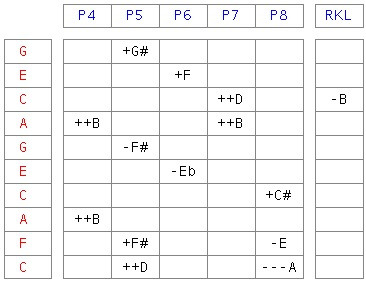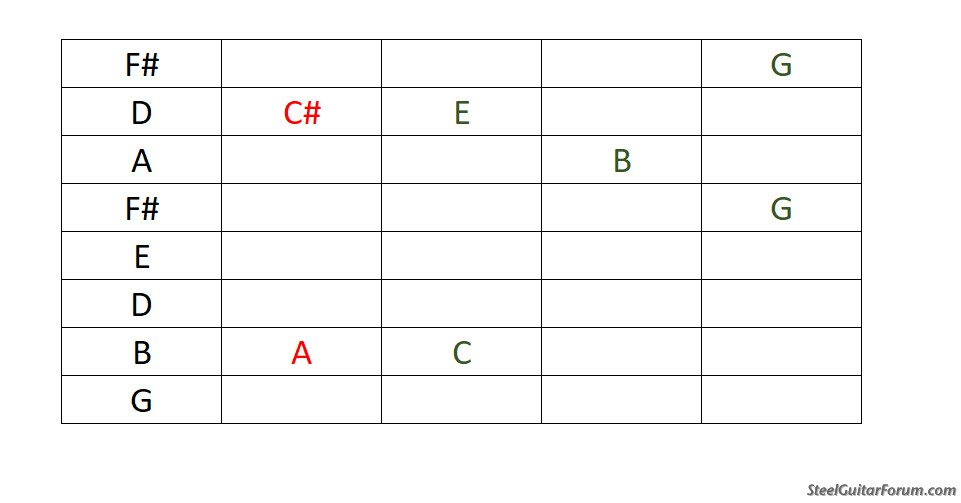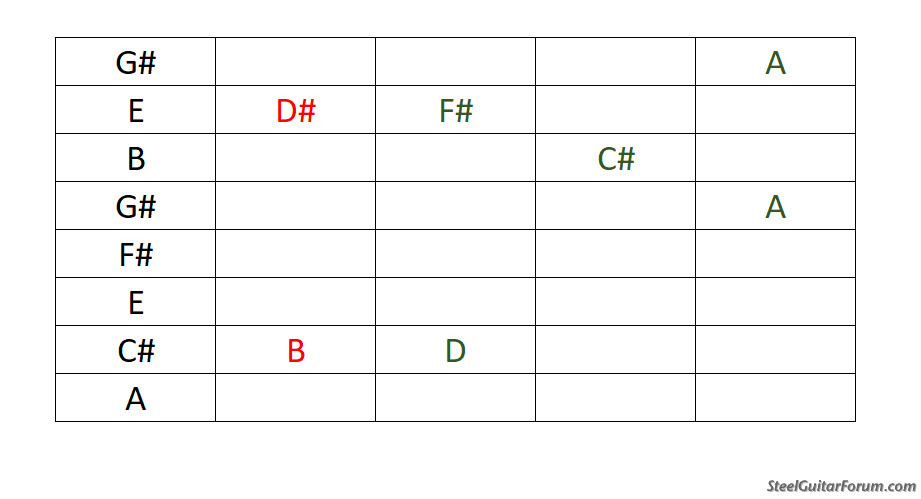| Author |
Topic: Standard C6 changes |
Tim Toberer
From:
Nebraska, USA
|
 Posted 24 Nov 2021 11:15 am
Posted 24 Nov 2021 11:15 am |
|
| Most of the discussions on this forum are over my head. I'm new to PSG and I want to set up an 8 string in A6, B6 or possibly B6 universal of sorts. I hear people often refer to normal or standard C6 changes, but I don't know what they are? I look at copedents and a few are obvious like lowering the 3rds to make a minor, raising the 6 to a 7th etc. What are the most useful or common C6 changes? I know in E9 the changes often are to change the entire chord from a I to a V etc. Is this done on C6 or is it typically to alter the base C chord? Sorry if this is confusing. Can anyone suggest a tutorial that explains this easily?? I just started playing 8 string C6 lap steel a few months ago. Pretty humbling so far. |
|
|
 |
Ken Metcalf
From:
San Antonio Texas USA
|
|
|
 |
Donny Hinson
From:
Glen Burnie, Md. U.S.A.
|
 Posted 24 Nov 2021 12:24 pm
Posted 24 Nov 2021 12:24 pm |
|
Tim, click on "Links" at the top of the page and follow that to the copedents section. The go to Jimmy Day's C6th. Those are the accepted and basic changes for the C6th tuning.  |
|
|
 |
scott murray
From:
Asheville, NC
|
 Posted 24 Nov 2021 1:18 pm
Posted 24 Nov 2021 1:18 pm |
|
Buddy's is almost identical to Jimmy's with a couple extra knee levers that are quite useful. Buddy used a G on top throughout the 60s before switching to D. not sure how you'd tune an 8-string C6 with pedals or how many, if any, knee levers you've got


to summarize pedals 5-8:
no pedals = C6 chord, Fmaj9 at string 9, Am7 at string 8
pedal 5 = D9 chord, F# half diminished (m7b5) at string 9, Am6 at string 8
pedal 6 = Cm6 chord, F9 at string 9, A half dim at string 8
pedal 7 = Cmaj9 chord, Fmaj9 #11 13 at string 9, Am9 11 at string 8
pedal 8 = A7 #9 chord
pedal 5&6 = D7b9 chord, F# dim at string 9, A dim at string 8, C dim at string 7
pedal 5&7 = D 13 chord
pedal 6&7 = F9 #11 13 at string 9
pedal 7&8 = A9 11 chord
I find raising my Es to F on pedal 4 much more useful, or a reverse pedal 6. I've got the standard pedal 4 on an extra knee
_________________
1965 Emmons S-10, 3x5 • Emmons LLIII D-10, 10x12 • JCH D-10, 10x12 • Beard MA-8 • Oahu Tonemaster
Last edited by scott murray on 24 Nov 2021 3:06 pm; edited 4 times in total |
|
|
 |
David Ball
From:
North Carolina High Country
|
 Posted 24 Nov 2021 1:33 pm
Posted 24 Nov 2021 1:33 pm |
|
I have an 8 string Jackson--3 and 3 that I leave tuned in C6. Great C6 guitar. I tune mine like the top 8 strings of Buddy's with D on top. The first pedal is pedal 4, the second is pedal 5 and the third is pedal 6.
My RKR is like Buddy's RKL. My RKL is like Buddy's LKR.
My LKL does what kind of what P8 would do--it lowers string 8 a half tone and a full tone, it raises string 7 a half tone and a full tone (feel stops on these) and it raises string 1 a half tone.
Dave |
|
|
 |
Aaron Clinton
From:
Calgary, AB
|
 Posted 25 Nov 2021 7:32 am Simple C6
Posted 25 Nov 2021 7:32 am Simple C6 |
|
This was my eureka moment for understanding what was going on. The pedal 5 D chord is rootless. I often combine pedal 8 with the knee lever for an A9 chord. I also often pull behind the bar to get some moves that are missing

_________________
and don't forget to boogie! |
|
|
 |
Tim Toberer
From:
Nebraska, USA
|
 Posted 25 Nov 2021 8:05 am
Posted 25 Nov 2021 8:05 am |
|
Thanks for the detailed responses! C6 Is such a harmonically dense tuning, it is really going to take some time to digest. I'm building an 8 string pedal steel using inspiration from some plans I bought on the internet. It's a simple pull release changer so it will be
limited. I'm really thinking of it more as a lap steel with a couple enhancements. I worked out a couple copedents that I want to try. I have been playing it with strings 4-11 of the universal tuning from Larry Bell's site. It's an E add 9 chord and It feels natural as a
guitar player (lo to hi) E G# B E F# G# B E. I can lower the middle E to D for the common E9 lap steel tuning too. I haven't installed any pedals or rods yet. I worked out some simple changes to give me a full A6 tuning E A C E F# A C E and a full B6 tuning
E G# B D# F# G# B D#. I will have to see what I can get to work. I have been switching between these tunings and overwhelming myself (in a good way). I'm learning a lot as I go and already have some improvements in mind for the next one, definitely 10 strings.
I really like the idea of a simple universal copedent and honing my lap steel techniques to get the most out of it.
Last edited by Tim Toberer on 25 Nov 2021 8:39 am; edited 1 time in total |
|
|
 |
Fred
From:
Amesbury, MA
|
 Posted 25 Nov 2021 8:39 am
Posted 25 Nov 2021 8:39 am |
|
Tim,
You should take a look at bob’s hybrid D6.
https://b0b.com/tunings/blee.htm
It’s C6 tuned up a step and has the basic E9 changes along with a pretty complete set of C6 changes. Both are in D instead. It would be difficult to get it all on a pull/release changer but you could get most of it.
Fred |
|
|
 |
Aaron Clinton
From:
Calgary, AB
|
 Posted 25 Nov 2021 10:59 am Micro Universal Copedent
Posted 25 Nov 2021 10:59 am Micro Universal Copedent |
|
The great Lew Houston's D9 is a micro universal copedent that overcomes single raise/single lower. It has four pedals and no knee levers. It did not make sense to me until I transposed the top half into E and the bottom half into C. It needs to be played with two feet.

_________________
and don't forget to boogie! |
|
|
 |
Aaron Clinton
From:
Calgary, AB
|
 Posted 25 Nov 2021 11:04 am Transposed Up
Posted 25 Nov 2021 11:04 am Transposed Up |
|
This is Lew's copedent transposed up into E.

_________________
and don't forget to boogie! |
|
|
 |
Aaron Clinton
From:
Calgary, AB
|
 Posted 25 Nov 2021 11:09 am Transposed Down
Posted 25 Nov 2021 11:09 am Transposed Down |
|
... and transposed down to C.

_________________
and don't forget to boogie! |
|
|
 |
b0b
From:
Cloverdale, CA, USA
|
 Posted 25 Nov 2021 3:58 pm Re: Simple C6
Posted 25 Nov 2021 3:58 pm Re: Simple C6 |
|
| Aaron Clinton wrote: |
This was my eureka moment for understanding what was going on. The pedal 5 D chord is rootless. I often combine pedal 8 with the knee lever for an A9 chord. I also often pull behind the bar to get some moves that are missing
 |
Consider lowering the 8th string to D on your 1st pedal instead of raising it. It's very useful to have the root of that chord. I did that on my 8-string D6th (G lowered to E) and it worked very well.
<small>And as a theory nerd, I suggest renaming D# to Eb on your chart for clarity, as it is the b7 in the key of F and the b3 in the key of C.</small>
_________________
-𝕓𝕆𝕓- (admin) - Robert P. Lee - Recordings - Breathe - D6th - Video |
|
|
 |
Aaron Clinton
From:
Calgary, AB
|
 Posted 25 Nov 2021 4:43 pm
Posted 25 Nov 2021 4:43 pm |
|
Thanks bOb! I will clean up my enharmonic equivalents. I am going to add the pluses and minus you use as well. I couldn't get enough travel in my Fender 400 to get the 3 semitone lower. It was fun to try though.
_________________
and don't forget to boogie! |
|
|
 |
b0b
From:
Cloverdale, CA, USA
|
 Posted 25 Nov 2021 9:50 pm
Posted 25 Nov 2021 9:50 pm |
|
| Aaron Clinton wrote: |
| I couldn't get enough travel in my Fender 400 to get the 3 semitone lower. It was fun to try though. |
Try a heavier gauge string.
_________________
-𝕓𝕆𝕓- (admin) - Robert P. Lee - Recordings - Breathe - D6th - Video |
|
|
 |
Ian Rae
From:
Redditch, England
|
 Posted 26 Nov 2021 4:51 am Re: Standard C6 changes
Posted 26 Nov 2021 4:51 am Re: Standard C6 changes |
|
| Tim Toberer originally wrote: |
| I hear people often refer to normal or standard C6 changes, but I don't know what they are? |
I'm going to describe the function of the pedals which are commonly referred to as 5,6,7&8 (regardless of their actual location). It's important to realise that although the E9 and C6 pedals appear to do much the same sort of thing, they're there for different reasons.
Pedals started life as a quick change between the E9 and A6 tunings to avoid switching necks. They gave extra scale notes so that you could play a lot of music without moving the bar and their function is partly melodic. The C6 pedals, on the other hand, replicate bar slants and take us out of the scale to give modulating chords so that their function is mostly harmonic.
These are the common C6 bar slants. In each case there is an unusable string which is in between frets.

Pedal changes enable 4-part chords

Notice that the D9 and F9 chords don't contain the root note (although it may be available on a lower string). This is confusing for beginners (it was for me!), especially as the D9 does double duty for Am6 and F9 is also Cm6.
Pedal 7 is a different animal.

It doesn't replicate a slant but instead is a voice-changer from C6 to G6, rather like the original E9 to A6 change before Emmons and Day separated it into the A and B pedals we're familiar with today.
As always, feel free to take issue with anything I've stated! 
_________________
Make sleeping dogs tell the truth!
Homebuilt keyless U12 7x5, Excel keyless U12 8x8, Williams keyless U12 7x8, Telonics rack and 15" cabs |
|
|
 |
Tim Toberer
From:
Nebraska, USA
|
 Posted 26 Nov 2021 11:55 am
Posted 26 Nov 2021 11:55 am |
|
| Quote: |
| You should take a look at bob’s hybrid D6. |
I can't seem to figure out how to quote properly ....
I saw this a while ago. I did research on this project for almost a whole year before I was able to start building. I also really like Sneaky Petes copedent. These look fun to try but a little complex for my simple steel.
| Quote: |
I'm going to describe the function of the pedals which are commonly referred to as 5,6,7&8 (regardless of their actual location). It's important to realise that although the E9 and C6 pedals appear to do much the same sort of thing, they're there for different reasons.
Pedals started life as a quick change between the E9 and A6 tunings to avoid switching necks. They gave extra scale notes so that you could play a lot of music without moving the bar and their function is partly melodic. The C6 pedals, on the other hand, replicate bar slants and take us out of the scale to give modulating chords so that their function is mostly harmonic. |
Okay this is the essence of what I'm struggling with. Thank you! That makes a lot of sense! Being that my changer is limited I'm trying to figure out what might be the most useful copedent for the styles I'm trying to learn. I recently discovered Billy Robinson and I see how much density is in the tuning itself using only slants. I want to add a few pedals to open up some more options, or reduce my reliance on the more difficult slants. So many possibilities....
| Quote: |
| The great Lew Houston's D9 is a micro universal copedent that overcomes single raise/single lower. |
Thanks for the lead on this guy! I'll be listening to some Conway Twitty, haven't thought of him for years! The early stuff is amazing!! |
|
|
 |
Ian Rae
From:
Redditch, England
|
 Posted 26 Nov 2021 4:35 pm
Posted 26 Nov 2021 4:35 pm |
|
The two basic C6 pedals, the home position, are 5&6. Not only do they give the D and F chords I described above, but together they get you a full diminished chord as well. Whatever you are planning I would aim to incorporate those two at least.
_________________
Make sleeping dogs tell the truth!
Homebuilt keyless U12 7x5, Excel keyless U12 8x8, Williams keyless U12 7x8, Telonics rack and 15" cabs |
|
|
 |




